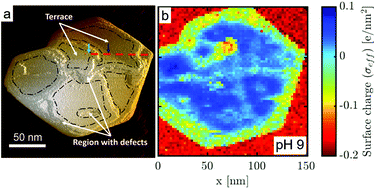Impact of surface defects on the surface charge of gibbsite nanoparticles†
Abstract
We use high resolution Atomic Force Microscopy to study the surface charge of the basal plane of gibbsite nanoparticles, with a lateral resolution of approximately 5 nm, in ambient electrolyte of variable pH and salt content. Our measurements reveal surface charge variations on the basal planes that correlate with the presence of topographic defects such as atomic steps. This surface charge heterogeneity, which increases with increasing pH, suggests that for a pH between 6 and 9 the defect sites display a stronger chemical activity than adjacent, apparently atomically smooth regions of the basal plane. Smooth regions display a slight positive surface charge of ≈0.05e per nm2 that hardly varies within this pH range. In contrast, near the topographic defects we observe a much lower charge. Considering the size of the interaction area under the probing tip, this implies that at the defect sites the charge density must be negative, ≈−0.1e per nm2. These measurements demonstrate that surface defects have a large influence on the average surface charge of the gibbsite basal plane. These findings will contribute to understand why surface defects play an important role in various applications, such as fuel cells, chemical synthesis, self-assembly, catalysis and surface treatments.



 Please wait while we load your content...
Please wait while we load your content...